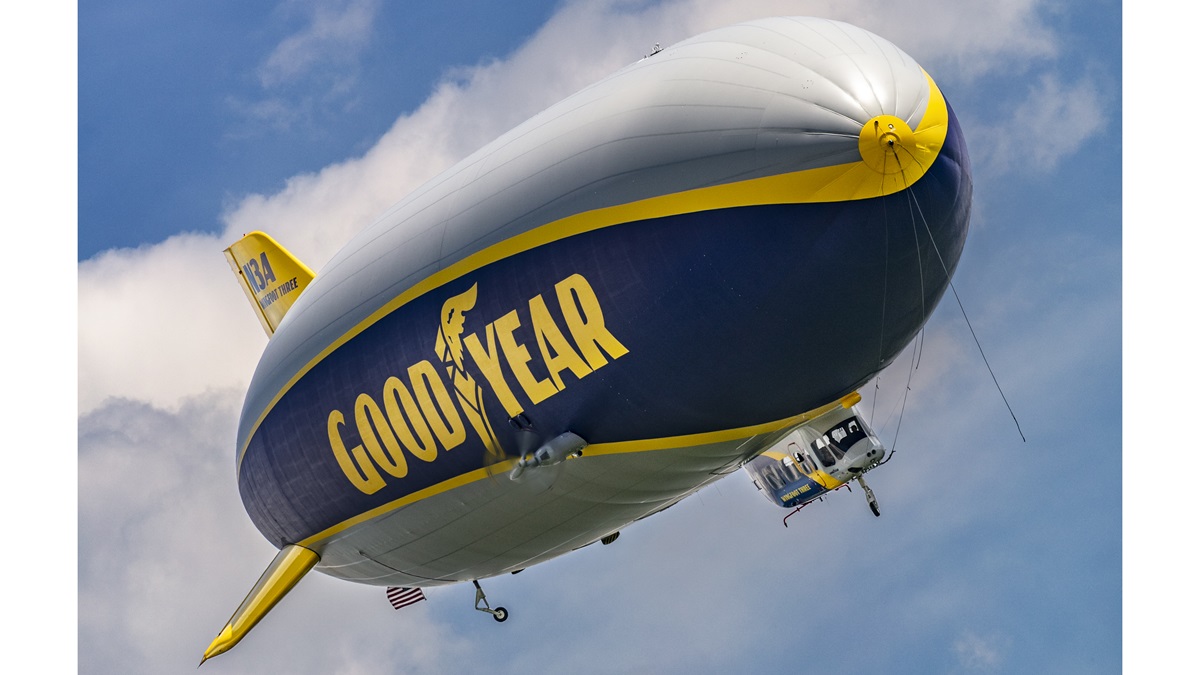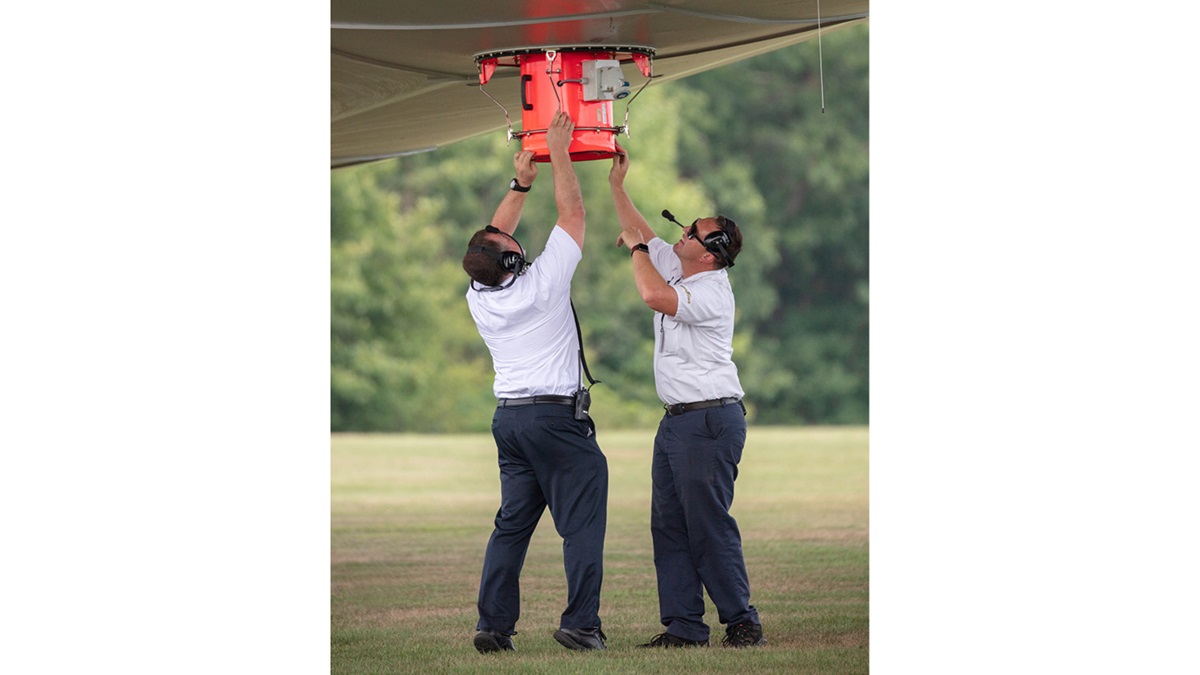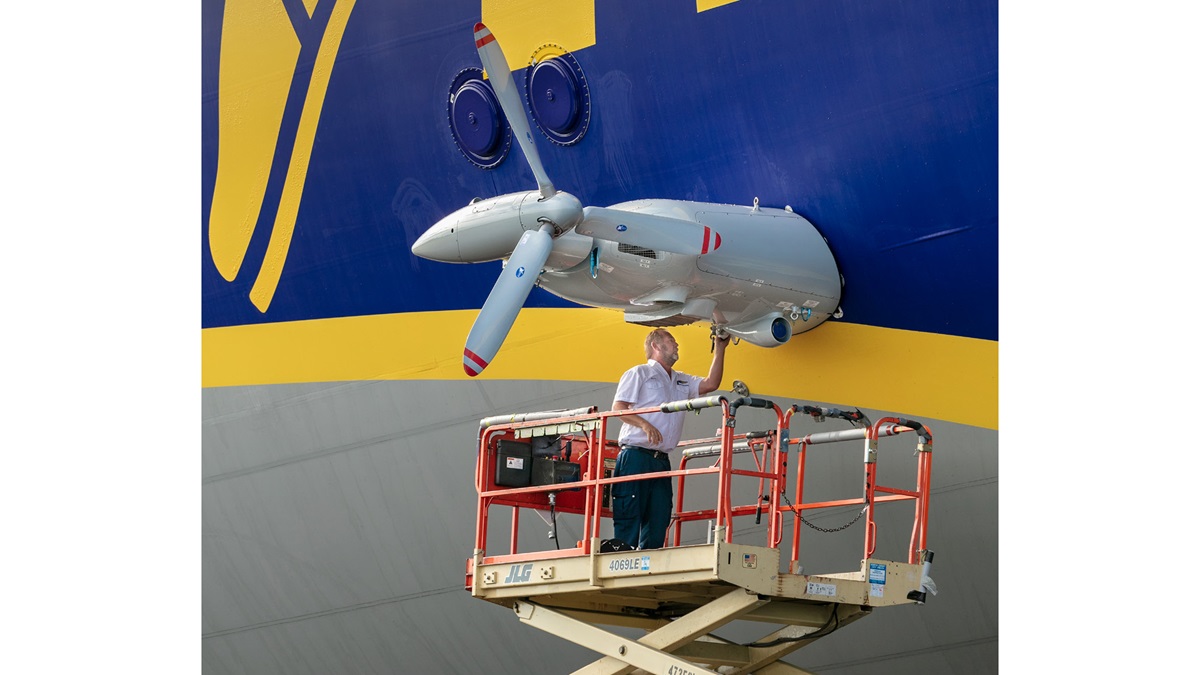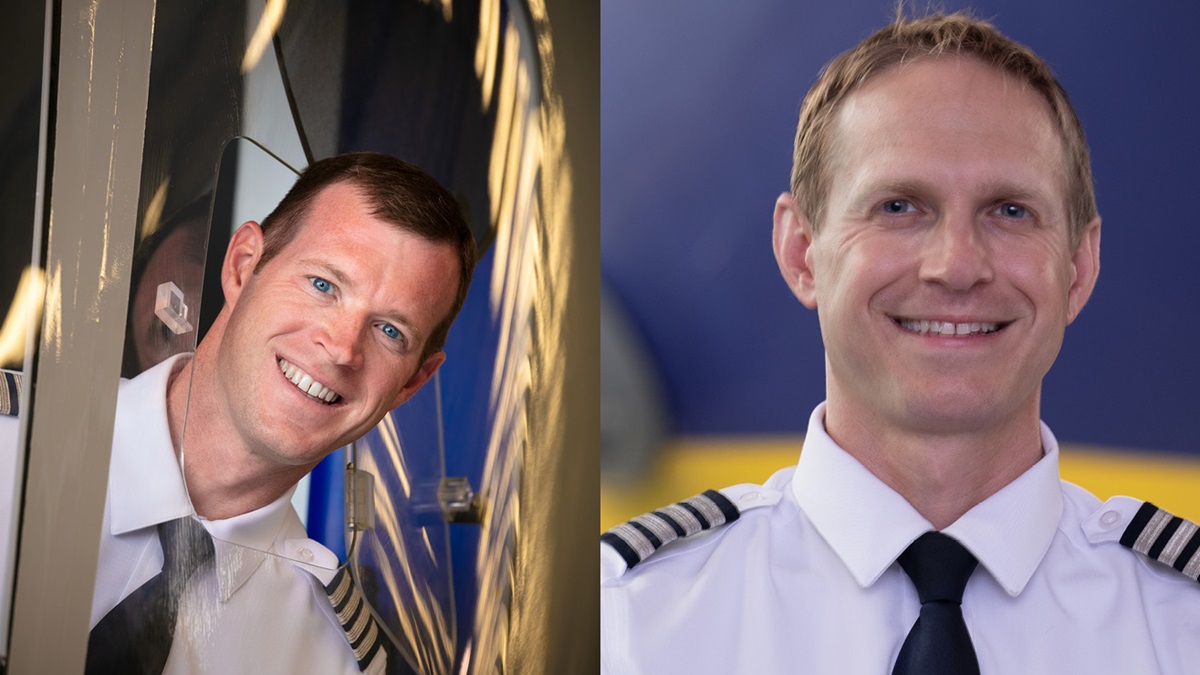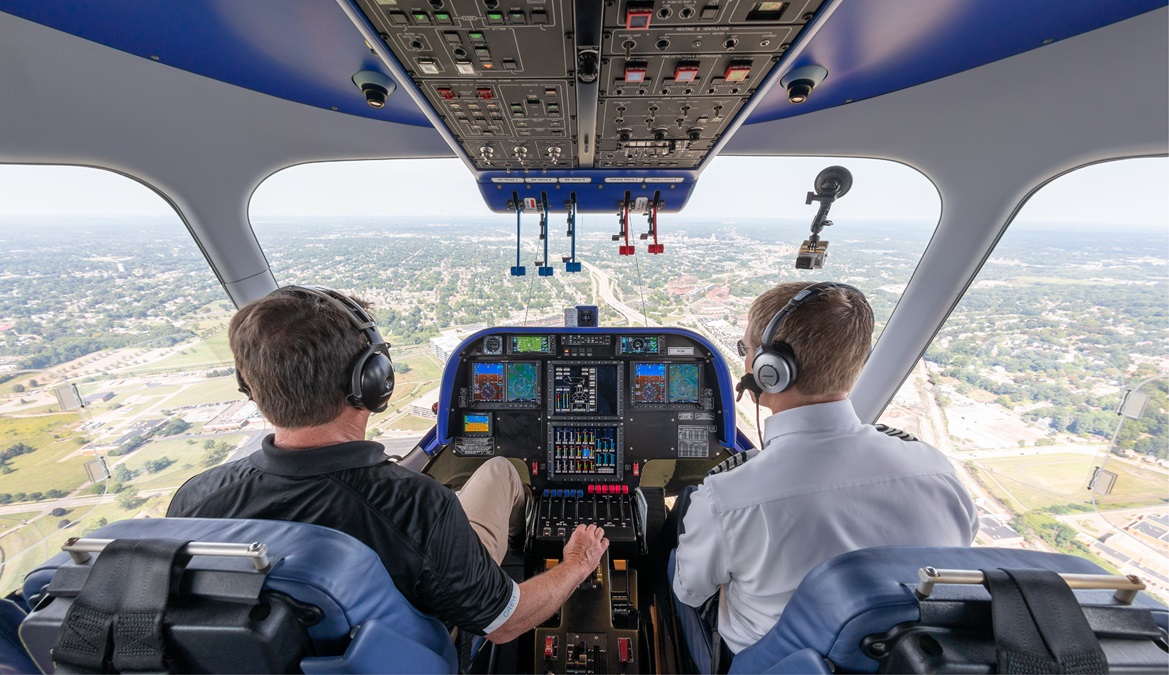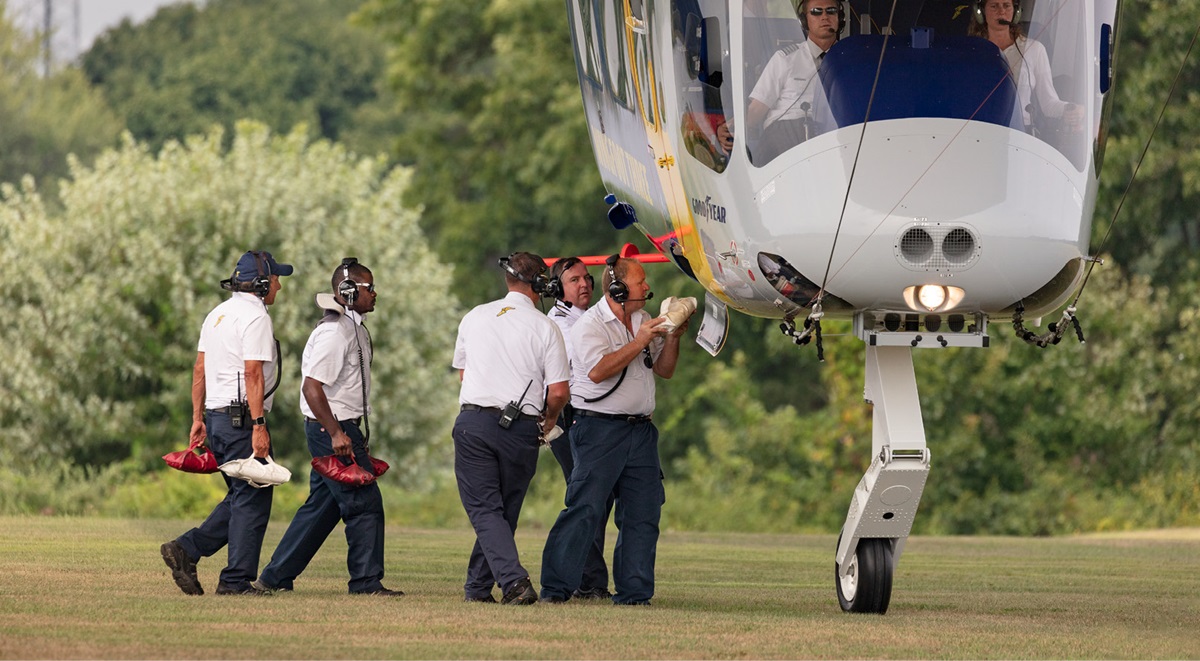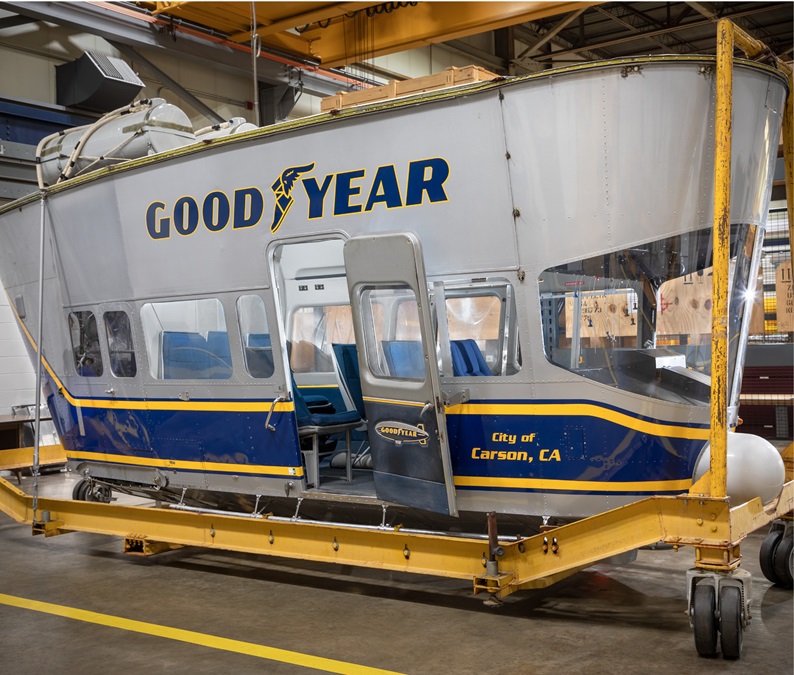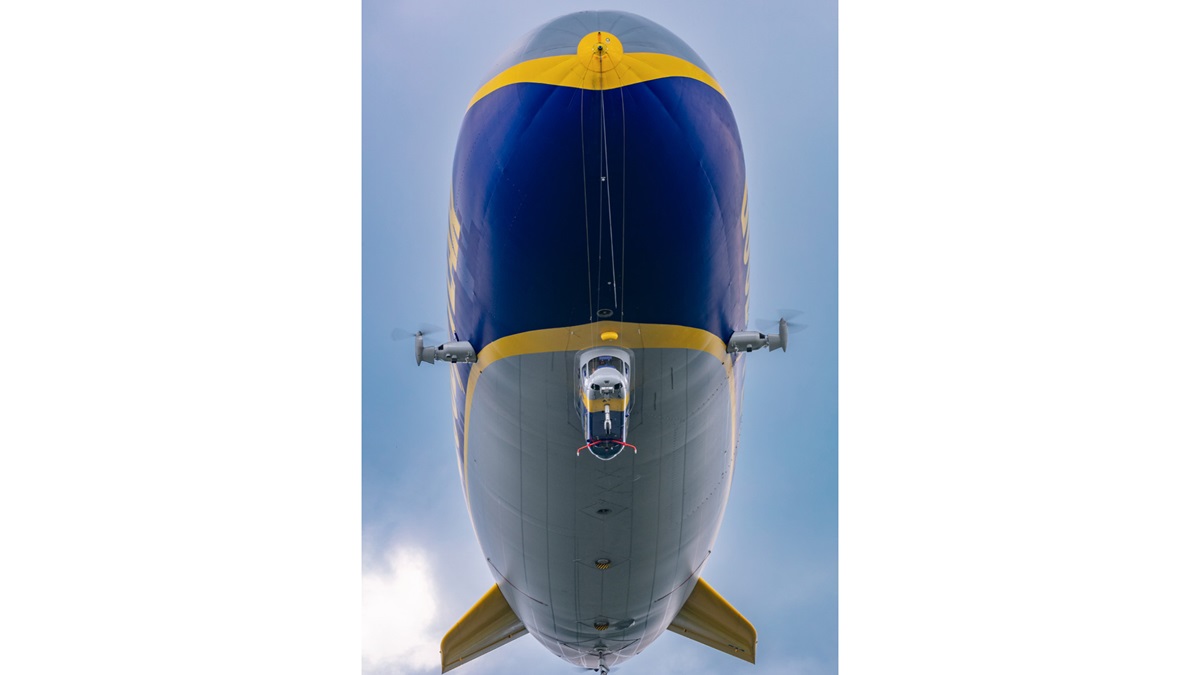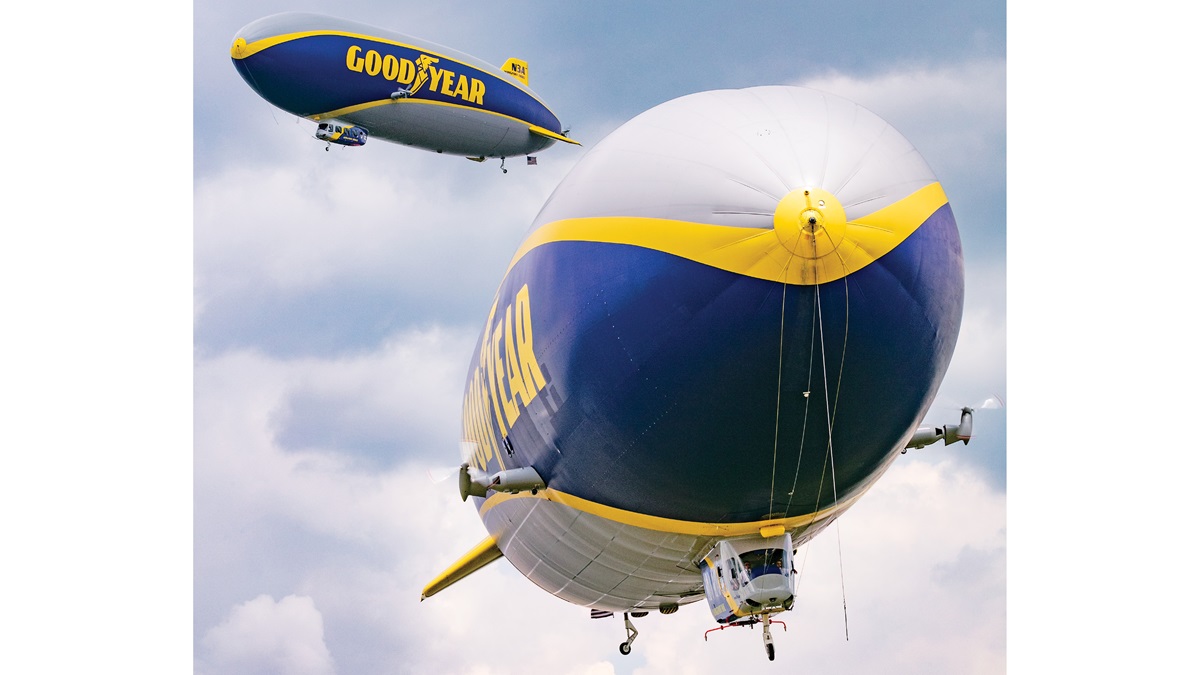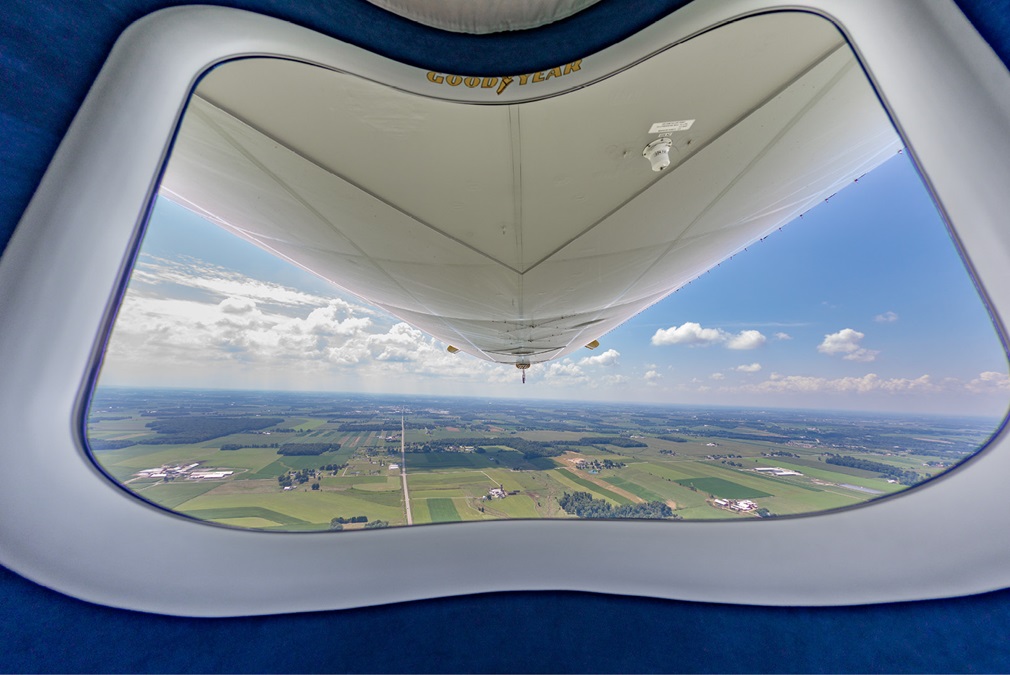Big business
A sign of the times
Gone are the twentieth-century non-rigid GZ–20 series of blimps Goodyear flew for decades. In 2011, the company announced its decision to retire the blimps in favor of a new generation of semi-rigid airships, the NT series—for New Technology. The move brought back together Goodyear and its partner of long ago, Zeppelin Luftschifftechnik GmbH, based in Friedrichshafen, Germany. The two last worked together in the 1920s, when the Goodyear-Zeppelin Company developed the huge dirigibles that were fashionable at the time.
The first result of the latest partnership was the launch of Wingfoot One—N1A—in 2014, the first of three zeppelins designed by Zeppelin and Goodyear and built by Goodyear at its now 101-year-old blimp hangar at Wingfoot Lake near Akron, Ohio. Wingfoot One is based in Pompano Beach, Florida. Wingfoot Two came along in 2017 and is based in Carson, California. Our ride is the brand-new Wingfoot Three, which received its airworthiness certificate a few days ahead of our visit in August 2018. It will call Wingfoot Lake home.
We are fortunate to witness an especially unusual sight—all three airships at Wingfoot Lake. Wingfoot Two is tucked in the back of the behemoth hangar undergoing its annual inspection.Three is just finishing its certification flights. And One, which had meandered from Florida to St. Louis to cover a sporting event over the weekend, is returning to Wingfoot Lake for some light maintenance and to finish up some training for new crew members. The three are rarely all together.
With One trucking cross-country toward Ohio, Adam Basaran, assistant chief pilot, decides we should dash out to intercept them for the trek back to the lake. But you don’t exactly sneak up on a blimp when you’re in a blimp. Photographer Chad Slattery and videographer Warren Morningstar jump at the chance to do some blimp-to-blimp photography; after all, it’s not an opportunity you get every day.
The blimps rarely fly high enough to be out of cellular telephone coverage, so coordination with the One crew is easy, and soon I am in the left seat of Three, running through checklists with Basaran, getting ready to start the three 200-horsepower Lycoming IO-360 engines staged around the Zeppelin’s 246-foot envelope—yep, that’s nearly as long as a football field. Inside is about 300,000 cubic feet of helium, equivalent to about 2.2 million gallons—enough to fill six Olympic-size swimming pools, although I’m not sure why you’d want to do that.
You don’t exactly sneak up on a blimp when you’re in a blimp.With its carbon fiber frame inside the envelope, ballonets (the fore and aft bags that can be inflated with air to compensate for the changing pressure of the helium and to manage pitch), and the composite 14-seat gondola hung from below the forward section, the aircraft will “weigh” more than 19,000 pounds empty. But, of course, that is a relative term because the helium will allow us to be up to about 440 pounds lighter than air for takeoff and landing; maximum weight on the ground is about 880 pounds. This day we take off about 700 pounds heavy.
Each of the three Lycomings is connected to a gearbox that allows them to turn the 9-foot, three-blade composite Hoffman props—all four of them—at about half the rpm of the engines. And, yes, you read correctly. There are four propellers on those three engines. One engine on each side of the envelope provides most of the forward thrust, and each propeller can be tilted up through 120 degrees. The aft propeller can be tilted down 90 degrees to help raise or lower the nose. A belt-driven propeller 90 degrees to the centerline assists with yaw control. The only flight controls are the rudder and elevators—and the pilot has no direct control over any of them. Instead, the pilot controls the ship using a sidestick connected to a fly-by-wire (FBW) system that moves the flight controls to provide the response desired by the pilot. Unlike FBW systems in airplanes, this one doesn’t even have rudder pedals. “Pilots in training often note that their legs are tired at the end of the day from subtly pushing on the footrests,” Basaran says. “They can’t help themselves.”
With FBW and the well-positioned engines turning controllable-pitch propellers, the NT models are safer for passengers and easier to maneuver than the GZs, which had two Continental engines mounted on the gondola. “With the GZs you had to be moving to have any control. With the NTs we can fly really slowly, and even hover and back up, and still have control,” Basaran said. The former airline pilot flew the older models for about 18 months before transitioning to the NTs. The other benefit of the controllability is the need for fewer ground handlers during docking. The GZs might require as many as 18 handlers during passenger operations, whereas the NTs often operate with only a half dozen or so. In the GZs, the pilots had rudder pedals and a giant wooden wheel for moving the elevators.
While there were mostly mechanical systems on the GZs, the NTs are almost all electrically operated. Generators on all three engines provide power redundancy. A secondary FBW flight control system backs up the primary system.
The NT’s cockpit looks like something out of a business jet, with dual Garmin G500Hs and dual GTN 650 navigators. Additional displays show the positions of the flight controls and the engines plus the status of various systems. The aircraft are equipped for IFR flight, although at the time of our visit, none of the NTs had been IFR certified. With the GZs, crews only occasionally flew in instrument conditions, as the ships’ purposes are to screamGoodyear to the world as they go leisurely across the country. And it works. When one is nearby, you will look up. And, of course, you will see the fleet providing aerial coverage of major sporting events across the nation. The gyro-stabilized camera system can be mounted just under the chin of the gondola and is controlled by a technician on board. On the ground, a Goodyear employee in a specially built trailer receives the microwave feed and sends it on to the television networks. Goodyear provides the feed to the networks at no charge, the publicity selling enough tires to satisfy the corporate bosses in Akron.
When the Wright brothers sold their first military airplane in 1909, it touched down on Goodyear tires—the year Goodyear launched its aeronautics operation. The company’s understanding of rubber and fabrics led to the construction of its first airship in 1911, and it has been in the blimp business ever since. With many millions invested in developing the new NT series and millions more spent annually on supporting the three locations—each with a crew of about 20 technicians, maintenance personnel, and pilots—plus enormous expense in maintaining their gigantic hangars and their custom-built support equipment, the company clearly values the exposure the airships provide.
With our 30 minutes or so of checklists complete, Basaran calls for engine start as the ground crew scrambles into position. He communicates with the lead ground controller via radio. At Basaran’s direction, the crew members add or remove bags of metal shot to get the airship to the correct weight for takeoff—and, already thinking ahead—for our landing weight. If necessary, the pilot in flight can release water ballast stored beneath the gondola to reduce the landing weight.
Part of a blimp pilot’s job is understanding the physics of lighter-than-air flight. Helium changes temperature quickly, and when it does, it expands or shrinks. Stationary on the ground on a sunny day, it can heat up fast, causing it to expand. If all is working correctly, valves should then force air out of the ballonets. If not, helium gets vented—this is expensive and to be avoided. Climbing to altitude where the pressure is less, the helium will expand, except as it cools it shrinks, so understanding the rate of each is important. Simply moving through the air at different speeds cools or warms the massive envelope. Regardless, the crews never rely on automation. The airships have at least one person with them 24 hours a day, inside the hangar or out, making sure they are properly balanced—the child that never grows up!
With Basaran satisfied with the weight, I follow his direction in starting the engines, turning a knob on the overhead panel. The start sequence is similar to that of any Lycoming, except the controls are electronic; there’s no mechanical linkage to the levers in the cockpit. Upon start-up, the large bottom center display lights up with a plethora of information about each of the engines—manifold pressure, oil temperature and pressure, rpm, exhaust gas temperature, plus fuel flow and pressure are all shown in large red, green, and yellow bars, plus digital readouts. With finely tuned digital controls, fire detection and suppression systems, and a water detection system in the fuel tanks, no Lycoming has ever been treated so well.
With another round of engine checks complete Basaran declares us ready to go, and I lift the yellow levers on either side of the throttles for the forward engines to swivel the propellers up 90 degrees. I then move the yellow lever controlling the aft propeller position to the Takeoff/Land position, causing it to move 90 degrees down. With that, we are backed off the mast truck by the ground crew and with engine reverse. With a clear path across Wingfoot Lake, I move the aft thrust lever to the Takeoff setting, advance the main engine throttles, and move the control stick aft. Like a helicopter, the big airship simply levitates. Rotating the main propellers slightly forward changes the thrust vector and we move ahead. At about 20 knots, I reposition the aft propeller to the Flight position, which pushes us forward as well.
Swiveling the front propellers into a complete tractor position, we head across the lake with the airship now behaving rather like a fixed-wing aircraft, with the joystick the primary control. Except it’s more like driving an ocean liner than an aircraft. I find myself moving the joystick stop to stop as the nose moves left and right and pitches up and down. I soon realize I’m creating some sort of pilot-induced oscillation as I attempt to correct for each movement of the ponderous beast. “Just let go,” advises Basaran, the ever-patient flight instructor. I do, and the ship soon settles down, but still slowly pitches up and down in the sea of air. Fortunately, Basaranis monitoring the helium pressure and adjusts the valves to compensate as it cools from us now moving, but expands with our increasing altitude. We level off 500 feet or so above the ground and try some turns. The trick is to anticipate the movement of the nose and to reverse the input in time to stop the turn—but to then quickly allow the stick to re-center so the blimp doesn’t start a turn the other way. Sounds simple, but with any kind of turbulence, it’s trickier than it sounds.
I’ve flown the GZ blimps before, plus a couple of models of smaller airships, and they are all ponderous. And while the NT is no sports car, it is remarkably more maneuverable than other airships, even though it is by far the largest airship flying. Basaran further demonstrates that over the Goodyear racetrack near its headquarters in Akron. There, we slow down and I gradually tilt the main propellers up and all the way to 120 degrees. Meanwhile, the aft propeller is positioned down 90 degrees and in a few seconds we are backing up. Later I move the main propellers to 90 degrees, up and voilà—we’re hovering.
Soon we’re headed west, looking for Wingfoot One to come over the horizon. Basaran says six- to eight-hour cross-country trips are typical, but 10 to 11 hours is not unusual. With 306 gallons of avgas on board, endurance can be extended to as much as 24 to 26 hours by running the aft engine at reduced thrust; the airliner-style lavatory in the back a big help on such long legs. Cruise speeds can be as high as 55 knots, which we saw at times, but at those speeds the Zeppelin becomes more difficult to control. Forty to 45 knots is the sweet spot, but sometimes the airships will meander along as slowly as 30 knots—being seen is the goal. Forty knots or so is the speed that allows the ground crew to keep up. No sense in the blimp arriving early at the next stop, because it can’t land without a ground crew and mast truck. The maintenance support 18-wheeler truck carries a portable mast with it in case the mast truck breaks down.
Eventually, Wingfoot One heaves over the horizon. The twin giant cruisers with their distinctive blue, silver, and yellow paint schemes soon tool along in formation, riding the air together. The big cabin windows and especially the large curved window across the back make for a great viewing platform.
Back at Wingfoot Lake, Wingfoot One makes a touch and go next to the hangar and then we come in for a full stop. Lined up into the wind, we basically drive the big ship down onto the grass, landing on its nosewheel (yes, that’s a Goodyear tire on there) with the aft engine positioned to hold the tail up until we are on smooth ground. Basaran deftly rolls the behemoth toward the mast truck with the ground crew assisting on the ropes. Soon we are hoisted up to the mast and ready to shut down.
The crew makes it all look perfectly normal—just another day at the office—but for everyone else in the world, seeing a blimp causes people to take notice. Goodyear helpfully supplies a parking lot next to the rural road that runs by the hangar, just for the gawkers. The lookers are out of their cars, cellphones aimed at the sky—the images being turned to electrons and headed for Facebook and beyond. Just another day at work for the world’s largest corporate icons.
Email [email protected]
Spec Sheet
Specifications
Powerplants |
Length |
Height |
Max width |
Max envelope width |
Envelope volume (70% helium) |
Seats |
Gondola empty weight |
Static lift |
Maximum dynamic lift |
Total usable lift |
Max weight | (without helium)
Fuel capacity |
Endurance |
Max level speed |
Goodyear Zeppelin NT
3 Lycoming IO-360s,
200 hp each
246 ft 4 in
57 ft 6 in
64 ft 7 in 50 ft
46 ft 7 in 46 ft
297,490 cubic ft
12+2
2,626 lb
2,940 lb
1,102 lb
4,042 lb
19,780 lb
302 gal usable/1,812 lb usable
24+ hours
70 kt
Goodyear GZ-20A
2 Continental IO-360s,
210 hp each
192 ft
59 ft 6 in
50 ft
46 ft
203,000 cubic ft
5+1
3,472 lb
2,530 lb
800 lb
3,330 lb
13,442 lb
294 gal usable/1,764 lb usable
24+ hours
43 kt
All specifications are based on manufacturer’s calculations. All performance figures are based on standard conditions and maximum weights unless otherwise noted.

